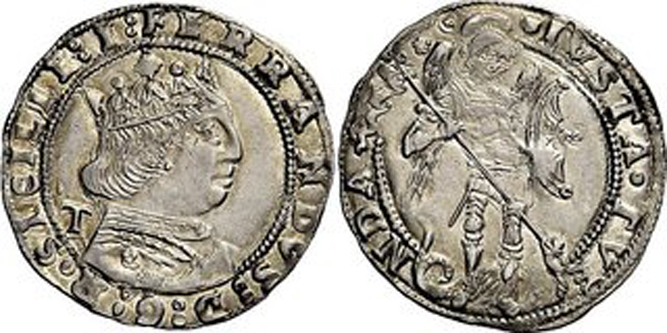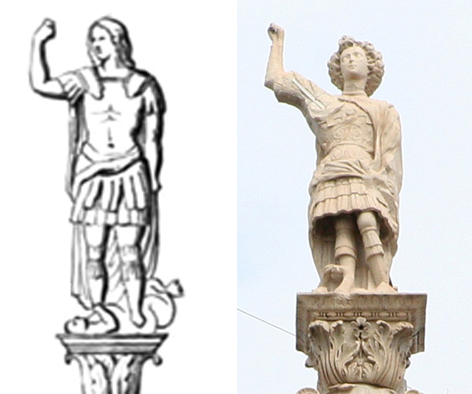NOTES ON THE THREEFOLD SCHEME OF THE TAROT TRUMPS IN CONTEXT
Prolegomena to a study of the groups, subjects and sequence of the Tarot trumps
(mostly an art(ist) appreciation exercise)
A depiction of heaven and earth will place heaven above earth; everyone intuitively understands this. The things of heaven are higher than the things of earth. So, in a vertical hierarchy, where would you then put depictions of
concepts and
ideas, or personifications of moral concepts like
allegories? Since they are not people you can meet or things you can bump into, nor are they real but untouchable like the heavenly bodies and supreme realities like God on his throne, such symbols will be placed higher than earth and Man but lower than heaven and God, in the
middle space between the two. This is what the tarot trump sequence does, and so do countless other works showing formally similar hierarchical orders. Only the specific iconographic content will differ, depending on the context and function of the work. This is the
threefold scheme of the trump sequence.
When we look closely at the various orders, we find that there was far from being total chaos. A first impression is of a good deal of regularity which, however, is hard to specify. Now the cards which wander most unrestrainedly within the sequence, from one ordering to another, are the three Virtues. If we remove these three cards, and consider the sequence formed by the remaining eighteen trump cards, it becomes very easy to state those features of their arrangement which remain constant in all the orderings. Ignoring the Virtues, we can say that the sequence of the remaining trumps falls into three distinct segments, an initial one, a middle one, and a final one, all variation occurring only within these different segments.
Game of Tarot, p. 398.
The threefold architecture of the trump sequence that Dummett discovered is not just a quirk of Tarot - it is a basic principle of spatial organization in iconographic vertical hierarchies - the basic moral valuation of hierarchical space, the low, middle, and high places; the center, and the sides. It forms a part of what Aby Warburg in 1912 described as the "...noch ungeschrieben 'historischen Psychologie des menschlichen Ausdrucks'" (the yet-unwritten 'historical psychology of human expression'). It is so basic, intuitive and natural that it is essentially unconscious and remains unmentioned, assumed, in discussions of how to read art. It is not a complicated insight, but it is profound; it has enough analytic power to generate new ways of viewing some artistic productions, for instance blowing life into a seemingly static monument like Donatello's tomb for Giovanni XXIII (see below in the examples I analyze in their threefoldness).
It was in September 2013, after a week or so of seriously wrangling with three "triumphs" (Love, Death, Eternity), a narrative that I saw in the trump sequence, that I appear to have truly begun to realize Dummett's threefold structure for the profound insight it was. From my notebook:
"We can look at the Monopoly squares and say "that's Atlantic City". With a little digging / research we can say it is Atlantic City, first third of 20th century.
"Likewise with Tarot we can look at the trumps and say they contain a moral allegory and with a little research locate it in the first half of 15th century Italy.
"But neither was intended to
teach what the symbols represent, although we can draw a lesson from either of them. Court cards not numbered; rank is implied. Similarly the court cards don't tell a story, although they are a meaningful hierarchy. Similarly for Chess figures or any game with symbolic figures representing the hierarchy.
"It would be absurd to suggest that the order of the court cards was invented to teach how a court was organized. It would be absurd to suggest that the Chess pieces teach how a kingdom is organized. Both
can do that, in a vague way, but that it not their intention. The understanding of the hierarchy is implicit, expected of the audience.
Similarly, all Italians of the 15th century would recognize the vague hierarchy in the trumps: celestial and eternal things are higher than moral allegories, and moral allegories are higher than human stations/types. These are the three divisions recognized by Dummett, and already recognized in the 19th century (and arguably the 16th).
"The nature of the differences among the various trump orders shows that there was a broad understanding of these three divisions, and the overall hierarchy. "
"Threefold scheme of art; planets (children), Schifanoia, pictures of people having visions, etc. Pseudo-Mantegna perhaps most relevant scheme:
1. Ranks
______ __Muses (poetry, art)
2. Ideas --- Liberal Arts (science, intellect)
_________Virtues (morality)
3. Celestial
"(Three registers) Check descriptions of Schifanoia, Ps.-Mantegna, etc. for an authoritative statement to that effect."
Looking for any authority who described "threefoldness" in vertical hierarchies proved difficult; it became apparent that it was such a fundamental, underlying and completely
natural basis for the spatial organization of iconographic information, that people describing such art assumed it rather than explained it as a principle.
I found a few art historians who pointed in that direction, such as Dale Kinney, "The Apse Mosaic of Santa Maria in Trastevere", in Elizabeth Sears and Thelma K. Thomas, eds.,
Reading Medieval Images: The Art Historian and the Object (U Michigan Press, 2002), pp. 19-26:
Where should the viewer start 'reading' this mosaic? Literally, with the inscriptions? In the center? From the bottom? From the top? Structure, both physical and pictorial, provides an intrinsic hierarchy and with it, a place to begin. (p. 22)
She then proceeds with her analysis of the verticality, horizontality, and
in situ qualities of the work, along with the inscriptions. She concludes (p. 25):
It takes desire and effort to read them, a physical premonition of the intellectual exertion that will be required to penetrate the allegory once it is perceived. To the art historian, this is a signal that visual analysis has done its work, and it is time to move on to the library.
(this is another implication of my motto, "con gli occhi et con l'intelletto")
Another one was Alastair Fowler,
Triumphal Forms: Structural Patterns in Elizabethan Poetry (Cambridge UP, 1970):
A more pervasive but also more elusive element, whose bearing on literary forms we are only beginning to grasp, is the spatial character of Renaissance thought (2). I shall only touch on one aspect of this: the tendency to order ideas in visual schemes (especially linear sequences). The dominance in the Renaissance of the pseudo-Horatian doctrine ut pictura poesis has long been obvious. But the application of the doctrine to literary structure as distinct from texture or imagery, is far from obvious. (p. 17)
Fowler's note 2 says: "This topic is brilliantly discussed by Fr. W(alter) J. Ong in
The Barbarian Within (New York, 1962), Ch. V, "System, Space and Intellect in Renaissance Symbolism"; see also the same author's "From Allegory to Diagram in the Renaissance Mind",
The Journal of Aesthetics and Art Criticism, XVII (1959)." I was not able to see Ong's book, but I could get his article, but found it concerned with the influence of printing on the representation of allegorical tableaux, and otherwise too diffuse generally to find the kind of authoritative "quote" on the insight I was looking for.
I realized I would have to do it myself, and assembled a few examples from art I was working with at the time, as well as those more generally known to us (such as the E-Series and Costa's Cappella Bentivoglio triumphs). Finally, when reading Aby Warburg in order to understand Schifanoia better, I came across his formulation "historical psychology of human expression", and realized that the threefold structure was an example of this. Shorthly thereafter I realized why it was "psychological" - the terrestrial (bottom, ground) is tangible,
real; the celestial (planets, stars, the divine) is real, visually tangible, but between them is an impassable gulf - we can't go up there, we can't touch those things: we can't fly. So this "middle space", the "air", becomes, naturally, the realm of the
conceptual, the quasi-real (when personified), thought-objects, personifications of ideas, values, the means by which the intellect bridges the gulf between the lower and the higher reality. This is why personified and allegorized morality goes in the middle section, why the designer put it there, and why no one would have had a second thought as to why it was where it was, as a coherent section of the sequence.
Vertical hierarchy (structure and function of composition impose constraints and variations)
Physical : Bottom-Middle-Top
Value of placement: Low-Middle-High
Descripton: Terrestrial, literal - Conceptual , figurative (of intellectual or moral principles)- Celestial, divine
(Psychological origin - terrestrial and celestial are real, but man can't fly - he can't touch the celestial. The middle - the "air" - becomes the home of the conceptual)
Six examples -
I. Palazzo Schifanoia, Sala dei Mesi

1. Acts of Borso (terrestrial)
2. Moral qualities of the decans (personified; decans are ten-degree segments of the 360 degree circle of the zodiacal band, to which astrologers assign moral qualities)
3. Gods of the months (Manilius), with mythological and planetenkinder scenes
Because the terrestrial and heavenly registers are self-evidently so described, I shall only detail why the "
faces of the decans" between them are in fact a moral register.
April -
faces of the three decans

(for
Ibn Ezra, Raphael Levy, Francisco Cantera, eds.,
The Beginning of Wisdom, Johns Hopkins UP, 1939, pp. 159-160; for
Picatrix, William Kiesel and Hashem Atallah, eds.,
Picatrix; The Goal of the Wise (Ouroboros Press, 2002), quoted in Shawn Nacol,
Scion's Handy Guide to the Decans (PDF, 2005), pp. 10-14)
1.
Ibn Ezra, "A hirsute woman, who has a son and who wears clothing partly burnt."
Picatrix, "A woman of curly hair, having a single child who is dressed in clothes like unto fire, and she herself dressed in similar clothes.
And this is the face of plowing and working the earth, of sciences, geometry, of sowing seed, and making things."
2.
Ibn Ezra, "A man who resembles a ram in his face and his body, whose wife resembles an ox; his fingers are like goat's hoofs.
That man is very hot and gluttonous, and he does not have peace of mind; he cultivates the earth, and he drives the oxen to plow and to sow."
Picatrix, "A man like the figure of a camel and having on his fingers are hooves like those of cows, and he is covered completely with a torn linen sheet.
He desires to work the land, to sow, and to make things. And this is the face of nobility, power, and of rewarding people."
3.
Ibn Ezra, "A man whose feet are white and likewise his teeth, which are so long that they stick out beyond his lips; the color of his eyes as well as his hair is reddish, and his body resembles that of the elephant and the lion,
but prudence does not reside in him, since all of his thoughts are bent on doing evil; he is seated on a cloth. There go up also a horse and a little dog."
Picatrix, "A man of ruddy coloring with large, white teeth appearing outside of his mouth, and a body like an elephant whose legs are long; and there ascends with him one horse, one dog, and one calf.
And this is the face of laziness, poverty, misery and fear."
II. Triumphal Arch of Alfonso V in Castel Nuovo, Naples
1. Triumph of Alfonso (terrestrial)
2. Virtues (moral)
3. Archangel Michael flanked by saints Anthony and Sebastian (celestial)
The rivers
Sebeto and
Volturno (under the arc as the "vault of heaven", i.e. the "world", centered, symbolically, in the land of Naples between these rivers) - the
virtù of the King causes the land to flourish (the rivers are not personified below, where two decorative griffons bear the horns of plenty, so it is not the land that has brought Alfonso victory, but rather Alfonso that has brought the land victory).
Looks like this now -

As engraved in 1870 -

The statue at the top

is the Archangel Michael, who until sometime after the 18th century had wings, as in this engraving from 1756 -

This Michael was probably the model for the image on a coin of Ferdinando of Aragon, son of Alfonso and king of Naples 1458-1494.

An actual example -
In the engraving from the 1870
Moniteur des architectes above, you can vaguely see the dragon Michael is slaying (I have not been able to find a good photograph with a top view of the pedestal).
Alfonso's arch is not merely a triumphal arch, commemorating a victory, but also serves an architectural function as a gate. One of constraints of the design was that it match the height of the two towers it stands between. This accounts for the second, decorative arch above the main entrance arch. What precise symbolism it had remains obscure, but the presence of a statue with an antique toga suggests that the people on it represented philosophers or other great figures of the past, i.e.
exempla, belonging to the
moral aspect of the threefold division, rather than the
terrestrial and real Triumph of Alfonso, or, because it is
under the Cardinal Virtues, to the
celestial realm.
Threefold symbolic structure of entire monument -
 http://www.rosscaldwell.com/images/triu ... iteur6.jpg
http://www.rosscaldwell.com/images/triu ... iteur6.jpg
Boiled down to symbolic essentials of the hierarchy -
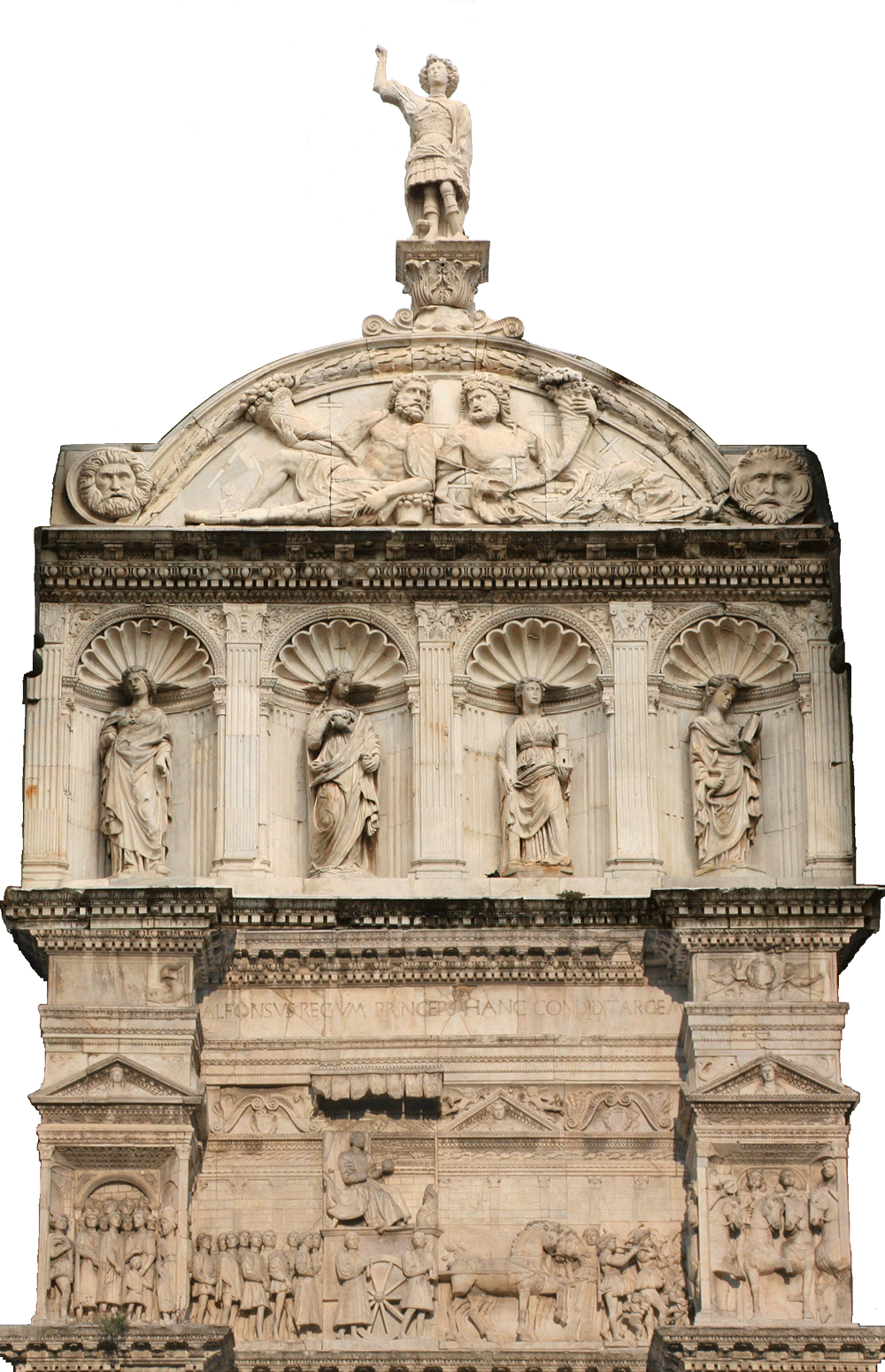 http://www.rosscaldwell.com/images/triu ... hbasic.png
http://www.rosscaldwell.com/images/triu ... hbasic.png
Note that the four Cardinal Virtues stand for "all virtue". The iconography of the triumphal arch is a contextualized and idealized representation of Alfonso's triumph, not merely an attempt to depict what really happened. We know from written descriptions that the Theological Virtues were also present at the event, and of the Cardinal Virtues only Justice played a major role, along with four other Virtues, Magnanimity, Constancy, Clemency and Liberality; Temperance, Fortitude and Prudence played no particular role at all; Fortune-Occasio, who played a central role in the actual triumph, is not represented on the arch, and neither is Julius Caesar, another central figure of the real event (although he might have been in the middle section, with the second arch).
III. Lorenzo Costa, Cappella Bentivoglio
Triumph of Death (
starts with allegory, introduces concept of "literal" as a subset of "terrestrial" or "real" (actually vice-versa))

1. Triumphs of Fame (and Fortune) and Death (and Chastity)
2. Exempla (Fame), souls ascending (Death)
3. Souls ascending, angels, God the Father, Jesus, Mary (in Death triumph only; the two compositions are a diptych)

In the Death triumph, the physical space of the viewer is important - he is already looking up, above his head - this composition
starts in the conceptual realm, with an allegory. Yet the picture can still be analyzed in the usual threefold way. In this case, the triumph, although strictly speaking
allegorical, is presented as
real, as it might actually be seen on the ground. The weight of the geographic features all around emphasize the point - this allegory
is the "terrestrial", bottom part of the structure. We can now understand that our terms need some refinement; the lowest level is not always a depiction of the literally real, but is also a
literal depiction of
some kind of reality. As in the "quadriga" reading of scripture (and Dante), the first, most basic and lowest level is the "literal"; since all art is representational (even Borso's acts, while real, are idealized representations of those acts), we can see that the lowest level, the terrestrial, worldly, or mundane, can actually be seen as a subset of the
literal. In the case of Costa's painting, the "literal" reality is the Petrarchan text, and this forms the lowest register of the underlying threefold structure.

But there seems to be a real story woven into the allegory: the death of a child, standing for all deaths. We are not part of Death's long train, we enter the scene from a different angle. Our eye might first meet an exotic musician, perhaps Orpheus, his back turned to us: this is a private mourning we are coming upon. Or, we may first fall upon a young woman presenting a nude child, partly covered by the somber robe of the musician, who looks straight at us. This must be the dead. As our eye is drawn inward, Costa's placement of the two other nudes suggests an ages of man motif, first a young, beardless man, next a bearded mature man. Nudity symbolizes the purity of the soul, so these men are deaths at various ages. Like the child, these perhaps represent real people who would be known to the intended original audience of the composition.
Our eye is drawn to where Death meets Chastity (virtuousness), an explicit representation of Petrarch. Then following further, finally we get to the visual center of the composition, Death itself, pointing upward. Going up from Death's scythe, we immediately enter a celestial panorama, conceptually moving from sadness to joy; schematically it is a series of concentric rings occupied by souls, saints, apostles and angels respectively, until the inmost space, the realm of divinity proper. We note that the first souls above the scythe's blade have become angelic infants; one is nude, and looks like the child gazing at us at the beginning, and two are wearing red and green, which with white are the same colors as the virgins meeting death below. In Dantean symbolism these colors stand for the Theological Virtues of Faith, Hope and Charity (perhaps it is Dante and Virgil in the distance). In these three children, then, the allegory and the real reference, our entry point, of the composition are blended.
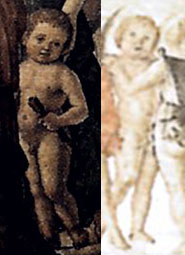
The moral overlay suggests that the mountain is part of the moral landscape: the grim procession is
descending from the mountain, or, we are mentally
ascending it, to contemplate death. The presence of hermits in the procession recalls another famous triumph of death, in Pisa. Despite the implication of a vast, murmuring throng, accompanied by mournful music, the mountain and hermits remind us that the mystery of death is encountered in solitude and silence.
Costa's work conflates with vertical values of space and placement
perspective uses of those spaces; the three-dimensional aspect allows God to be both the highest and most distant, as well as at the
center of the encircling choir of angels, as the summit of the ascent. The change from linear and two-dimensional representations, which used size and placement alone to indicate importance, to three-dimensional perspective realism forces late-quattrocento artists like Costa to adapt space and placement accordingly; we are now invited to go
in and up, whereas before the perspective of the viewer was implicitly static - the picture did all the work for itself.
The dynamic nature of the interaction between the real and the conceptual in this painting makes it more challenging to map than a monument like Alfonso's Arch or a strict hierarchy like the E-Series, but applying the threefold analysis to it looks something like this -

The light blue is the entry point, the
ground of the viewer's perspective and expectations, where real and recognizable people meet the gaze; almost simultaneously the allegory or
moral stream in purple begins, with the musician's turned back; the blue fades and the purple stream grows larger as the gaze is drawn inward, and can go either straight upward or take in the side-streams of the Petrarchan allegory. In both cases these meet in the exact visual center of the painting, where the
celestial realm begins.
This discussion of Costa's Triumph of Death is something of a digression, since it does not illuminate the structure of the Tarot trump sequence
per se. But it illustrates how the threefold structure can be used to look at a composition in a new way; it has helped us broaden the definition of the lower level, and helps us appreciate works that similarly begin, on the lowest visual level, with allegories or moralities. However, as we can see in Costa, there is always a real terrestrial context in which to view the work, its ground in real events, or literal
representations of them.
IV. Donatello tomb of Giovanni XXIII
(structurally/conceptually equivalent to Costa Triumph of Death; Death implicit in function/meaning of monument; so in tomb context, the terrestrial level is the context itself, death is the "ground" of the monument)
1. Theological Virtues (same role as Virtue-Pudicità in Costa Triumph of Death)
2. Effigy of dead man ascending (middle - corpse is actually in the sarcophagus)
3. Mary and Jesus (welcome into the celestial realm)
The relationship of the viewer to the imagery is important again. Since I haven't found any photographs of the monument which show a person standing close by, I have added one in the proper dimensions.

One can immediately see that the viewer is looking
up at the Theological Virtues; already the mind is being taken on a climb,
ascending. Since the context of death does not need to be spelled out on a tomb (although it often is), the moral level, like in Costa, forms the first explicit or visual level.
With the idea of the "middle" space, and the analogy of Costa's and countless other depictions of souls ascending to heaven, we see now that the effigy of the dead man is figuratively ascending, on the wings of his faith and piety (the three Theological Virtues) into the bosom of heaven. By virtue of the threefold analysis, movement has been granted to a monument that seems static, which we would otherwise pass by without a second look.
In retrospect, I can see that this analysis works for other tombs too, like the Rosellini one we recently looked at. In this, however, there are no Theological Virtues; beneath the sarcophagus, at the base, there is a kind of Arcadian tableau of memento mori. As we know, on the side there is a chariot of the soul (the other side is invisible, apparently, to viewers). All in all, the pagan elements are kept low, as is appropriate in a Christian monument.
V. Pseudo-Mantegna (PsM) model book
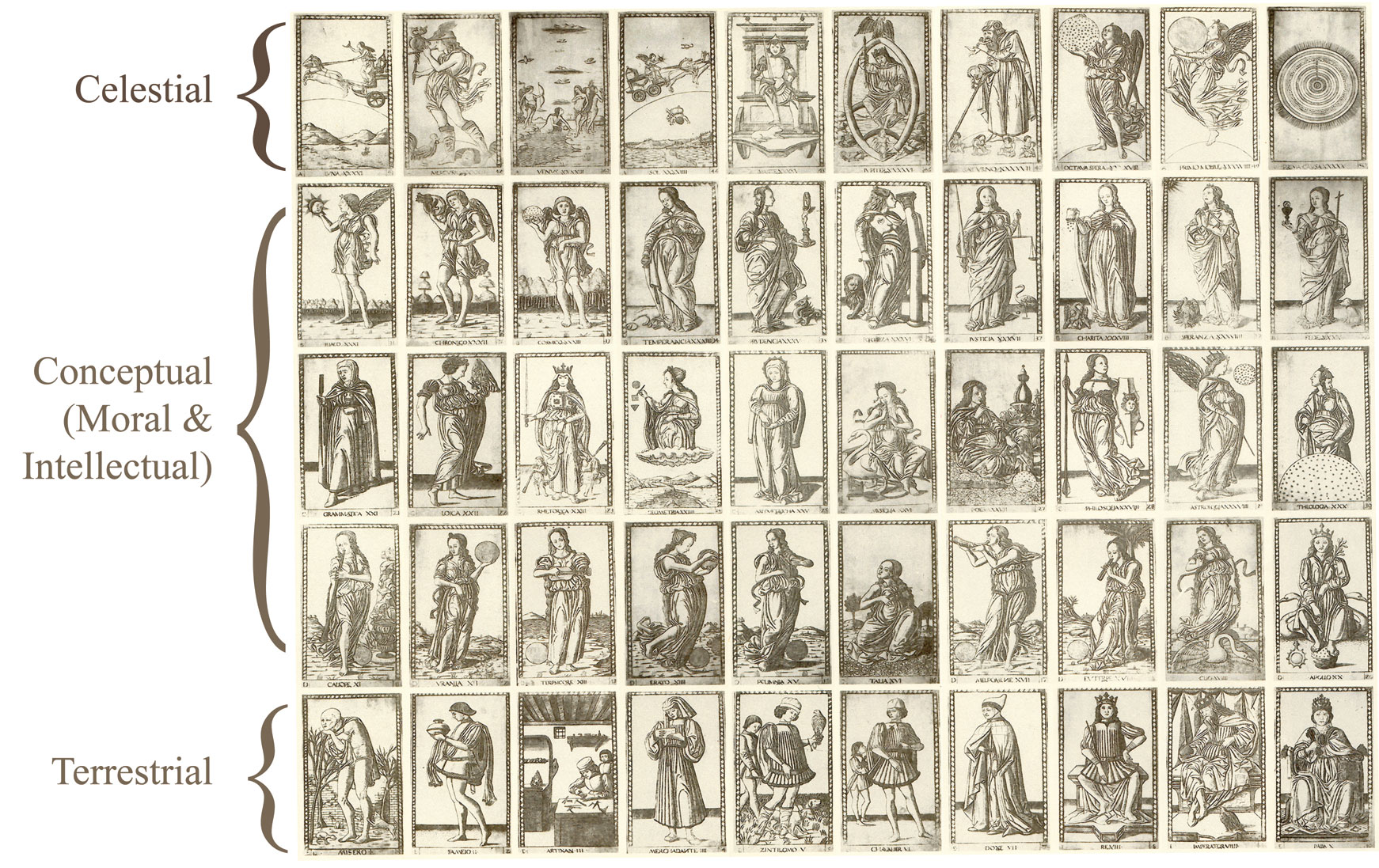
1. Human conditions
2. Muses, Arts and Sciences, Virtues
3. The celestial order
The middle, conceptual level has three parts, themselves hierarchically placed according to moral value. The lowest, the pagan muses; the middle, the intellectual arts and sciences; the highest, the moral virtues.
VI. Tarot trump sequence
1. Human types (highest and lowest; highest complete ranking of court cards)
2.
Virtù and
Fato
3. Heavenly order
Underlying, threefold conceptual structure of the trump sequence (like many other vertical hierarchies, why it made sense intuitively)-
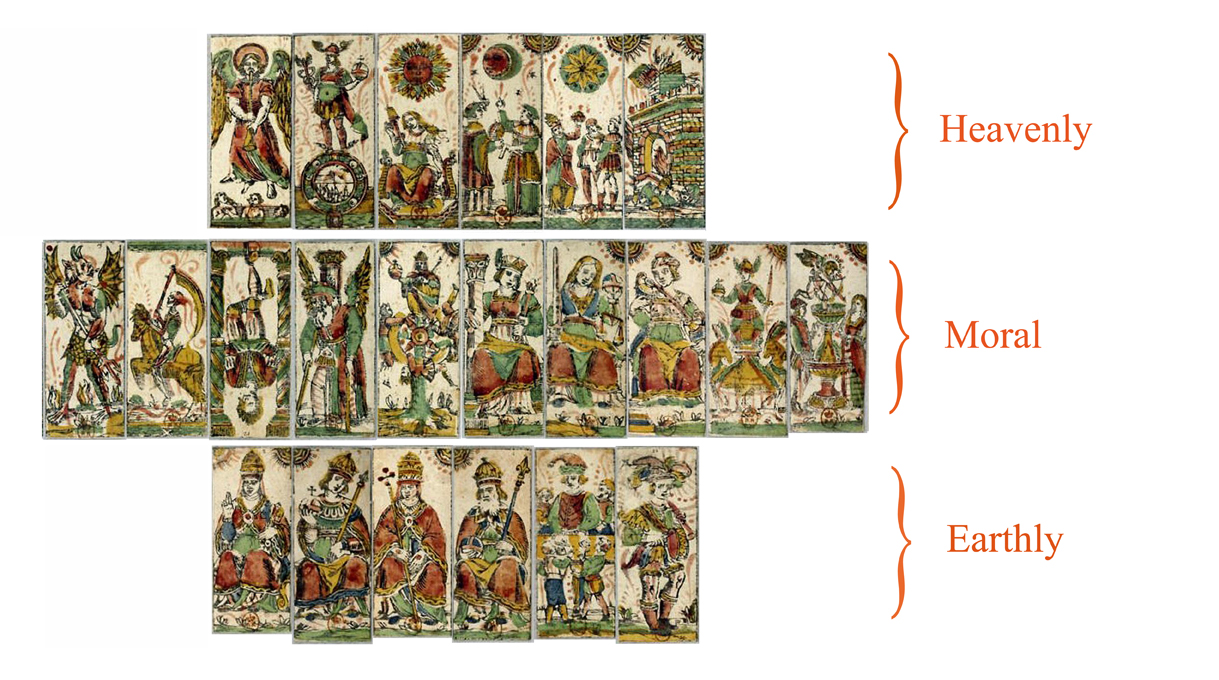 http://www.rosscaldwell.com/images/taro ... cture1.jpg
http://www.rosscaldwell.com/images/taro ... cture1.jpg
The ludic structure, how it was learned at the table (conventional groupings, one ludic (highest and lowest, a group because counting cards), no narrative necessary) -
 http://www.rosscaldwell.com/images/taro ... cture1.jpg
http://www.rosscaldwell.com/images/taro ... cture1.jpg
The tarot trumps are neither monument, nor painting, nor quasi-encyclopedic model-book; they are the pieces of a game. Their context is ludic, and play-function is therefore one of the constraints upon their design.
Note that for none of the above examples is it
necessary to understand the implicit, sometimes explicit threefold structure. As an analytical tool, it merely explains why morality goes in the middle space, and by looking at different works that way, we can understand what that middle space is. It is sometimes physically
in the middle of the composition, as in Schifanoia, Alfonso's triumphal arch, the E-Series, and the Tarot trump sequence; other times it is the physical placement, above the viewer's gaze, that places the entire composition in conceptual space, with the lowest, terrestrial realm implied or only hinted at in the composition itself, as in Costa's painting of the Triumph of Death; at other times, such as in Donatello's tomb monument for Baldassare Cossa, the composition begins in the middle, moral and allegorical, space, with the context remaining implied (death), but nevertheless clear.
This explains why the various sequences share the threefold sensibility, and why Dummett was able to reduce it to three families. It also explains why the designer chose these three types of subject matter, vertically arranged in three divisions, to illustrate the pieces of his game. It finally explains why it was easy for the players to understand the logic of the subjects, why they were where they were.
The threefold structure is a necessary, but not sufficient, explanation for the choice of subjects and their number - different subjects could occupy the lower, middle and highest levels (exactly as in the PsM, which is partly why so many people cannot believe it is not a card game related to Tarot); or, a story whose plot is so well known that the iconographic sequence clearly illustrates it and therefore doesn't need these symbolic ranking spaces; or, with the addition of numbers, the trumps need have no iconographic program at all, indeed no content at all but the numbers themselves - but with this threefold hierarchy of groups in the back of their minds, the specific placement of pieces in the hierarchy was easy to memorize. It can be done in a matter of minutes (with this basic "grouping method" I have taught several people completely unfamiliar with any Tarot at all the Bolognese order, including the counting trumps and the
equal-papi rule, to test how well it works).









